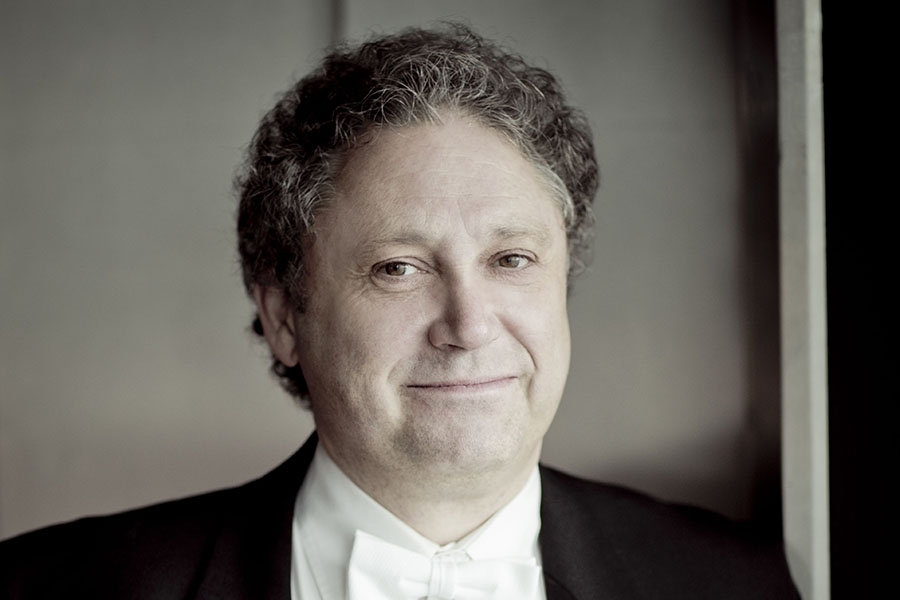Richard Egarr with DSO is a near-perfect “Brandenburg” host

Harpsichordist and conductor Richard Egarr was a delight Thursday in Dallas. Photo: Marco Borggreve
British harpsichordist, conductor and raconteur Richard Egarr blew into Meyerson Symphony Center Thursday night for an occasionally flawed, unfailingly engaging and often thrilling presentation of J.S. Bach’s complete Brandenburg Concertos with the Dallas Symphony Orchestra.
Each of the six works in this set demands a different ensemble, yielding numerous reconfigurations of personnel and seating onstage. Egarr, who succeeded Christopher Hogwood as director of the Academy of Ancient Music in 2006, used those moments for breezy, humorous and audience-friendly explanations of the upcoming music.
While giving quick verbal snapshots of aspects of the social milieu that produced these concertos in the early 18th Century, Egarr also managed to inform the audience on the all-important numerological content of Bach’s music. The more fascinating revelations included an explanation of that odd, one-measure adagio preceding the finale of the Concerto No. 3 in G; the abundance of groups of threes, sevens, and twelves throughout the works; and numerous other mathematical and metaphoric aspects of this music—all delivered with disarming enthusiasm and charm.
The one letdown in Egarr’s otherwise brilliant and accessible commentary was a demeaning, unnecessary and — worse yet — inaccurate characterization of Bach’s twentieth-century heir, Arnold Schoenberg, as a composer who “destroyed tonality” and practiced “musical Communism.” Why insult one great composer in order to exalt another?
Although the Brandenburg Concertos represent a high point of the European musical tradition, the works pose a challenge for modern orchestra in that instrumentation—and, indeed the concept and function of instrumental music—fundamentally shifted in the decades following Bach’s career. For the two concertos that demand what Bach would have considered a full orchestra, Egarr called on a much-reduced ensemble that included about two dozen strings. Flutes replaced recorders in the works that called for that instrument. But in a major bow to historical authenticity, two guest artists (Eric Smith and Rachel Phares) joined the ensemble with baroque-era violas da gamba for Concerto No. 6 in B-flat.
Egarr conducted from the harpsichord, positioned saddle-style — and often halfway out of his seat — on an adjustable piano bench that was turned sideways, his right hand on the lower of the two manuals while he steered the ensembles with his left. This was visually awkward and distracting, with Egarr, half bent over, legs apart, and back to the audience. More significantly, he was sometimes remiss in holding the ensemble precisely together at tricky moments, particularly at the slowing of tempos at closing cadences. Nor did he seem entirely in command of the acoustic qualities of the Meyerson in the early going, resulting in sometimes muddled ensemble sound.
Principals from the orchestra preformed with uniform brilliance in the numerous and difficult solo roles scattered through the set. Flutists David Buck and Kara Kirkendall Welch provided a glowingly rich collaboration for violinist Nathan Olson in the Concerto No. 4 in G, with Olson, the orchestra’s co-concertmaster, finding just the right level of baroque sensibility in the breathtaking passage-work. Principal trumpet Ryan Anthony maneuvered neatly through the incredible demands of the clarino trumpet part in Concerto No. 2 in F (with associate principal trumpet L. Russell Campbell backing him up out of the spotlight in less prominent sections of that difficult solo).
Egarr proved a soloist in his own right in the showy harpsichord passages in Concerto No. 5 in G; in spite of some tempo glitches elsewhere, here he demonstrated an impressive and convincing flexibility within the usually steady tempos demanded in baroque music.
Egarr presented the six concertos out of order, with Concertos 1, 6, and 2 followed by intermission and Concertos 5, 3, 4. The high point of the concert arrived in the penultimate item on the program, Concerto No. 3 in G: Here, the rich interplay of the three violins, three violas, and three cellos — and that wonderfully reflective Adagio, with its subtle harpsichord improvisations — epitomized the energy and momentum of this musical monument to the human spirit.
The program will be repeated at 7:30 p.m. Friday and Saturday and at 2:30 p.m. Sunday at Meyerson Symphony Center. mydso.com; 214-692-0203.


